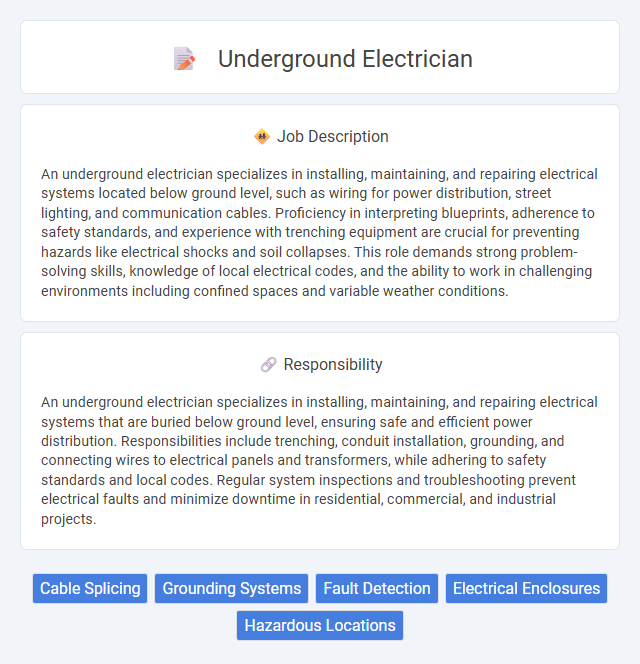
An underground electrician specializes in installing, maintaining, and repairing electrical systems located below ground level, such as wiring for power distribution, street lighting, and communication cables. Proficiency in interpreting blueprints, adherence to safety standards, and experience with trenching equipment are crucial for preventing hazards like electrical shocks and soil collapses. This role demands strong problem-solving skills, knowledge of local electrical codes, and the ability to work in challenging environments including confined spaces and variable weather conditions.
Individuals with strong physical stamina and a tolerance for working in confined, potentially hazardous environments are likely suitable for an underground electrician job. Those who are comfortable with high-risk situations and possess good problem-solving skills may find this role well-suited to their abilities. However, people prone to claustrophobia or who have difficulty working in physically demanding conditions might struggle in this occupation.
Qualification
Underground electricians must possess specialized qualifications, including certification in electrical systems and apprenticeship completion, often requiring OSHA safety training and knowledge of National Electrical Code (NEC) standards. Proficiency in handling high-voltage cables, troubleshooting underground electrical faults, and expertise in conduit installation are critical for job performance. Strong physical fitness, problem-solving skills, and familiarity with ground-penetrating technology enhance an electrician's ability to maintain and install subterranean electrical infrastructure effectively.
Responsibility
An underground electrician specializes in installing, maintaining, and repairing electrical systems that are buried below ground level, ensuring safe and efficient power distribution. Responsibilities include trenching, conduit installation, grounding, and connecting wires to electrical panels and transformers, while adhering to safety standards and local codes. Regular system inspections and troubleshooting prevent electrical faults and minimize downtime in residential, commercial, and industrial projects.
Benefit
Working as an underground electrician likely offers benefits such as competitive salaries and opportunities for overtime pay due to the specialized nature of the work. There is a probability of gaining valuable hands-on experience with complex electrical systems, enhancing career advancement potential. Safety protocols and union membership in many cases may provide added job security and health benefits.
Challenge
Working as an underground electrician likely involves navigating complex and hazardous environments, which can present significant challenges to safety and precision. The job often demands strong problem-solving skills to troubleshoot electrical faults buried underground, where visibility and access are limited. Navigating tight spaces and unpredictable conditions probably requires both physical stamina and careful adherence to safety protocols.
Career Advancement
Underground electricians specialize in installing and maintaining electrical systems below ground, offering expertise in conduit, wiring, and safety protocols. Career advancement opportunities include roles such as project supervisor, electrical contractor, and electrical engineer with further certifications and experience. Mastery of diagnostic tools and regenerative energy systems can accelerate progression to senior technical or managerial positions within construction and utility companies.
Key Terms
Cable Splicing
Underground electricians specialize in cable splicing, a critical skill involving the precise joining of electrical cables to ensure uninterrupted power transmission in subterranean environments. Mastery of cable splicing techniques enhances circuit reliability and safety by minimizing faults and electrical losses in underground distribution systems. Proficiency with insulated tools, heat-shrink tubing, and splice enclosures is essential for maintaining the integrity of high-voltage underground networks and complying with industry standards like IEEE and NEC.
Grounding Systems
Underground electricians specialize in installing and maintaining grounding systems that ensure electrical safety and system reliability in subterranean environments. These systems involve grounding conductors, rods, and mats designed to disperse electrical faults safely into the earth, preventing equipment damage and personal injury. Expertise in soil resistivity testing and adherence to NEC grounding codes is critical for effective grounding system installations in underground electrical projects.
Fault Detection
Underground electricians specialize in installing, maintaining, and repairing electrical systems buried below ground, with fault detection playing a critical role in their work. Advanced diagnostic tools such as cable locators, insulation testers, and thermal imaging cameras are employed to accurately identify faults like cable breaks, insulation failures, and grounding issues. Precise fault detection ensures minimal downtime and enhances safety while maintaining the reliability of underground electrical infrastructure.
Electrical Enclosures
Underground electricians specialize in installing and maintaining electrical enclosures that protect critical components from moisture, dirt, and mechanical damage in subterranean environments. These electrical enclosures are engineered to meet stringent NEMA and IP ratings, ensuring durability and safety in harsh conditions. Proficiency in wiring, grounding, and sealing techniques is essential to prevent electrical faults and maintain system integrity underground.
Hazardous Locations
Underground electricians specialize in installing and maintaining electrical systems in hazardous locations, such as tunnels, mines, and confined spaces with flammable gases or explosive dust. They must adhere to strict safety standards and use explosion-proof equipment compliant with NEC Article 500 and NFPA 70 guidelines to prevent electrical hazards. Expertise in grounding, bonding, and circuit protection is critical to ensure operational safety and minimize the risk of ignition in these environments.
 kuljobs.com
kuljobs.com